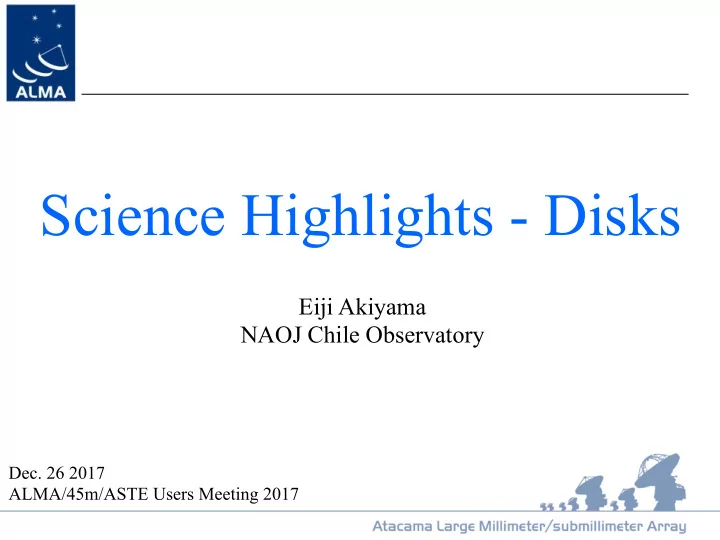

Science Highlights - Disks � Eiji Akiyama NAOJ Chile Observatory Dec. 26 2017 ALMA/45m/ASTE Users Meeting 2017
Outstanding Improvement � ALMA SMA 1 arcsecond 1 arcsecond
Gallery of Disks � HD142527 HK Tau V1247 Ori HD163296 Elias 2–27 HD169142 HL Tau TW Hya AA Tau HD 95086 V883 Ori Fomalhaut
Dust Trapping � Kraus et al. 2017, van der Marel et al. 2013, 2016 Intensity [Jy/beam] 2 × 10 -3 10 -3 0 0 ALMA 870µm ALMA + H-band ALMA + L’-band ・ Crescent structure implies dust trapping. ・ High pressure may be generated by an orbiting planet. ・ The presence of a planet is supported by NIR result (spiral feature).
Polarization Obs. � Kataoka et al. 2016a, 2016b, 2017 Stephens et al. 2017 Polarization due to self-scattering ・ Polarization fraction strongly depends on wavelength ・ Another method for confining dust size Derived dust size ~100 µm
Loomis et al. 2017 Mass Streamer � Casassus et al. 2013 Dutrey et al. 2014 AA Tau band 6+7 (271.6GHz) ・ 3 rings at 49, 95, and 143 au are found. streamer ・ Streamer structure was found at inner region. eg. HD142527, GG Tau ・ Warped disk structure ? simulation
Multiple Gaps � Tsukagoshi et al. 2016 Andrews et al. 2016 Dust Observations • Little large dust grain exist at the ring gap. • The ring gap at 22 au can be explained by a Neptunian planet. ref. Kanagawa et al. 2015, 2016
CO Depletion � Nomura et al. 2016 ref. Favre et al. 2014 Gas Observations 13 CO (3-2) C 18 O (3-2) ・ CO is drastically depleted inside of the CO snowline. ・ H 2 gas / dust = 1 ~ 0.1 ref. ~100 in ISM ・ The amount of CO directly affects the planet 0.41 ” x 0.33 ”� 0.41 ” x 0.33 ”� atmosphere. ISM ・ Amino acid might be formed from a little CO gas (Aoki & Kobayashi’s experiments).
Methanol Study � Walsh et al. 2014b Walsh et al. 2016 Theoretical prediction of CH3OH in protoplanetary disk n (CH3OH) / n (H) 1 10 100 r [AU] Gas phase Grain surface Species 10 AU 30 AU 100 AU 305 AU 10AU 30 AU 100 AU 305 AU Formaldehyde H 2 CO 3.7(12) 5.1(13) 1.5(12) 8.3(12) 6.7(09) 6.4(18) 3.4(17) 6.0(17) Methanol CH 3 OH 1.0(09) 2.2(11) 5.8(12) 1.7(13) 2.3(18) 8.4(17) 1.1(18) 8.8(17) Formic acid HCOOH 8.1(10) 7.5(11) 9.1(12) 8.2(12) 1.1(18) 2.4(17) 1.1(17) 3.3(16) Cyanoacetylene HC 3 N 2.0(12) 6.9(11) 2.1(11) 9.8(10) 1.7(18) 1.3(15) 8.2(12) 5.5(12) Acetonitrile CH 3 CN 5.5(12) 2.9(12) 6.9(11) 4.1(11) 1.2(17) 2.1(17) 2.7(16) 2.0(15) Propyne CH CCH 4.5(11) 8.2(11) 1.1(12) 1.8(12) 4.7(19) 1.0(19) 1.1(18) 2.5(17) ・・・ etc.
Methanol Observation � Walsh et al. 2016 12 10 8 mJy / beam 6 4 s < � � � � � 317GHz Cont.(>3 σ ) 2 0 -2 cont. emission ≥ 3 σ s s � � � 2 � � < - ´ � »
Discovery of HCOCH 2 OH � Jorgensen et al. 2012 Large organic molecules were found in IRAS16293 − 2422 star forming region. � Glycolaldehyde (HCOCH 2 OH) Credit: ESO/L. Calçada & NASA/JPL-Caltech/WISE Team�
Discovery of CH 3 NCO � Martin-Domenech et al. 2017 Ligterink et al. 2017 Methyl isocyanate (CH 3 NCO)
Discovery of CH 3 Cl � Fayolle et al. 2017 Methyl chloride (CH 3 Cl) CH 3 Cl can not be treated as prebiotic molecule but complex organic molecules can be formed in star forming region. �
Gerdes et al 2017 Trumbo et al. 2017 Solar System Bodies � Palmer et al. 2017 Lellouch et al. 2017 • 2014UZ 224 TNO object at 92 au observation ・ As results of ALMA & Blanco telescopes, it could be dwarf planet. ・ D = 635 ± 70 km ・ albedo = 13 ± 4 % • Europa, plume source investigation ALMA image Model image ・ nighttime (ALMA) & daytime (Galileo) image comparison ・ Heat excess in nighttime image is not due to endogenic heat flow 230 GHz but local thermal inertia. • Titan, Vinyl Cyanide has been confirmed at the Titan’s atmosphere. • Pluto, CO and HCN was detected in Pluto’s atmosphere.
www.almaobservatory.org� The Atacama Large Millimeter/submillimeter Array (ALMA), an international astronomy facility, is a partnership among Europe, North America and East Asia in cooperation with the Republic of Chile. ALMA is funded in Europe by the European Organization for Astronomical Research in the Southern Hemisphere (ESO), in North America by the U.S. National Science Foundation (NSF) in cooperation with the National Research Council of Canada (NRC) and the National Science Council of Taiwan (NSC) and in Japan by the National Institutes of Natural Sciences (NINS) in cooperation with the Academia Sinica (AS) in Taiwan. ALMA construction and operations are led on behalf of Europe by ESO, on behalf of North America by the National Radio Astronomy Observatory (NRAO), which is managed by Associated Universities, Inc. (AUI) and on behalf of East Asia by the National Astronomical Observatory of Japan (NAOJ). The Joint ALMA Observatory (JAO) provides the unified leadership and management of the construction, commissioning and operation of ALMA.�
Recommend
More recommend